Slutsk
Slutsk
Слуцк | |
|---|---|
City | |
 City Hall of Slutsk | |
 Flag  Coat of arms | |
 Slutsk Location of Slutsk | |
| Coordinates: 53°02′N 27°34′E / ��53.033°N 27.567°E | |
| Country | |
| Region | Minsk Region |
| Districts | Slutsk District |
| Founded | 1116 |
| Area | |
| • Total | 24.6 km2 (9.5 sq mi) |
| Elevation | 250 m (820 ft) |
| Population (2009) | |
| • Total | 61,444 |
| • Density | 2,500/km2 (6,500/sq mi) |
| [1] | |
| Time zone | UTC+03:00 (FET) |
| • Summer (DST) | UTC+03:00 (FET) |
| Postal code | 223610 |
| Area code(s) | +375 1795 |
| License plate | 5 |
| Website | Official website |

Slutsk (officially transliterated as Sluck, Belarusian: Слуцк; Russian: Слуцк; Polish: Słuck, Lithuanian: Sluckas, Yiddish/Hebrew: סלוצק Slutsk) is a city in Belarus, located on the Sluch River 105 km (65 mi) south of Minsk. As of 2010, its population is of 61,400.[2] Slutsk is the administrative center of Slutsk District.
Geography[]
The city is situated in the south-west of its Region, 26 km (16 mi) north of Soligorsk.
History[]
Slutsk was first mentioned in writing in 1116. It was part of the Principality of Turov and Pinsk, but in 1160 it became the capital of a separate principality. From 1320–1330 it was part of the domain of the Grand Duchy of Lithuania. Later it was owned by the Olelkovich and Radziwiłł families, which transformed it into a center of the Polish Reformed Church with a gymnasium and a strong fortress.
Following the 17th century, the city became famous for manufacturing kontusz belts, some of the most expensive and luxurious pieces of garment of the szlachta. Because of the popularity of the cloths made here, belts worn over the żupan were often called of Slutsk despite their real place of origin.
Slutsk was part of Russian Empire after Second Partition of Poland in 1793. It was occupied by Germany in 1918 and by Poland between 1919 and 1920 during Polish Soviet War. In 1920, it was the centre of a major anti-bolshevik uprising known as the Slutsk defence action. In 1926, there were 8,358 Jews (53.3% of the total population) in Slutsk.[citation needed] Until World War II and the Slutsk Affair, the city was predominantly Jewish; however, now the population includes no more than 100 Jews. Slutsk was occupied by the German Army on 26 June, 1941, and placed under the administration of Reichskommissariat Ostland. The period of German occupation ended on 30 June, 1944, when troops of the 1st Belorussian Front recaptured the town during the Minsk Offensive of the Red Army.
Massacre of Jews[]
During the German occupation of Slutsk, the Jewish inhabitants were systematically targeted for killing.[3] The first Jewish victims were killed in the garden on Monakhov Street during the initial days immediately following the arrival of the Germans on 27 June, 1941. The victims numbered between 70 and 120, according to different sources.[4]
Four months later, on 27 and 28 October 1941, one of the largest single massacres occurred, known as the Slutsk affair, when Jews were herded towards pits in the Gorovakha ravine, approximately 10km west of Slutsk, where they were shot. According to German sources the total number of victims was 3,400, while Soviet sources cite 8,000.[5] These killings were carried out by two companies of the German 11th Reserve Order Police Battalion and the Lithuanian 2nd Battalion, which was a German-sponsored Schutzmannschaft or Auxiliary Police formation established in Kaunas, soon after the Nazi occupation of Lithuania.[6]
A further massacre was carried out over several days during the spring of 1942, when the inhabitants of the "field ghetto" of Slutsk were taken to the forest near the village of Bezverkhovichi, 10km west of Slutsk, where they were shot or murdered in gas vans. According to survivors, the victims were driven to the execution site in two to four trucks on Mondays and Saturdays. The last Jews of the field ghetto were murdered on the Passover, 2-3 April 1942. The total number of Jews murdered at Bezverkhovichi is estimated to have been between 3,000 and 4,000.[7]
One of the last significant massacres of Jews occurred on 8 February 1943, with the liquidation of the "town ghetto" of Slutsk. The Jews were driven in trucks to the former estate of Mokhart, popularly called Mokharty, 5km east of Slutsk, where they were shot from behind in mass graves by personnel of the Minsk security police office. During the liquidation, some Jews fought back, shooting at the German and Latvian soldiers. In response, the Germans burnt the ghetto to the ground. Postwar court proceedings cite a minimum of 1,600 victims, of which 1,200 were murdered at the graves at Mokharty, the rest in the ghetto itself.[8]
Jewish community[]
The first indication of Jews in Slutsk is from 1583 when the city was part of Lithuania.[9] Formal recognition came in 1601. By 1623, Jews owned 16 homes. In 1691, Slutsk became one of the five leading communities of area of Lithuania.[9] By 1750 there were 1,593 Jews. Although this number represented a third of the cities population, 75% of the town's merchants were Jews, and a similar proportion accounted for Jewish ownership and merchandizing of alcohol.[9] After annexation by Russia in 1793, growth of the city slowed, in part due to it being bypassed by the railroad. By 1897 the Jewish community numbered 10,264 inhabitants, or 77% of the city population.[9] They played a central role in the cities markets, particularly in agricultural produce.
Slutsk was not insignificant in terms of Torah study. Among the rabbinic figures who served there were Yehudah Leib Pohovitser, Chayim ha-Kohen Rapoport, Yosef Dov Ber Soloveichik (1865–1874), and Isser Zalman Meltzer.[9] The famous Slutsk-Kletsk Yeshiva was found in Slutsk in 1883 by Rabbi Yaakov Dovid Wilovsky. Another outstanding scholar of learning in the Talmud and Torah who was also a Hebrew poet and became a Hebrew educator in the United States was Ephraim Eliezer Lisitzky, who was born and grew to his teens in Slutsk before emigrating to the U.S. According to legend the Baal Shem Tov visited Slutsk in 1733 at the invitation of Shmuel Ickowicz.[9] Despite this, the town was known for its anti-hasidic misnagdim. The Haskalah and modern Jewish political parties also were represented among the population.[9]
People[]
- – Belarusian painter
- – Belarusian painter
- Isaac Dov Berkowitz – Jewish and Israeli author
- Eliyahu Feinstein – rabbinic authority
- Yaakov Yosef Herman – Orthodox Jewish pioneer in America
- Semyon Kosberg – Jewish Soviet engineer
- Shneur Kotler – rosh yeshiva, Lakewood yeshiva
- Harry Lefrak – father of Samuel J. LeFrak, builder and realtor
- Shmuel David Leibowitz-Father of Boruch Ber Leibowitz
- Boruch Ber Leibowitz – leading rosh yeshiva
- Yisroel Leibowitz-leading Rabbi in Vilna from 1926
- Chaim Sholom Leibowitz-Son of Yisroel Leibowitz - Editor Of Birkas Shmuel, magnum opus of His Uncle Boruch Ber Leibowitz
- Isser Zalman Meltzer – Rabbi of Slutsk from 1903 to 1923
- Anastasiya Prokopenko, world champion and Olympic bronze medalist in modern pentathlon
- Gregory Razran, (1901-1973), Russian American psychologist
- Princess Sophia of Slutsk, medieval Eastern Orthodox saint
- Fabijan Šantyr (1887 - 1920), Belarusian poet, writer and public figure who is regarded as “the first victim of [the Bolsheviks] in…Belarusian politics and literature”[10]
- Edward Sperling – Jewish writer and humorist
- Mikola Statkevich – Belarusian politician
- Meyer Waxman – Rabbi and author
- Mikhail Yakimovich – Belarusian handball player
- Lidia Yermoshina – Belarusian politician
- Shaul Yisraeli – religious Zionist rabbi
Twin towns — sister cities[]
Slutsk is twinned with:[11]
 Brovary Raion, Ukraine
Brovary Raion, Ukraine Kalevalsky District, Russia
Kalevalsky District, Russia Moshenskoy District, Russia
Moshenskoy District, Russia Ryazansky (Moscow), Russia
Ryazansky (Moscow), Russia Rzhev, Russia
Rzhev, Russia Serpukhovsky District, Russia
Serpukhovsky District, Russia Shaki, Azerbaijan
Shaki, Azerbaijan Sisian, Armenia
Sisian, Armenia Staromaynsky District, Russia
Staromaynsky District, Russia Tczew, Poland
Tczew, Poland
See also[]
- Slutsk Affair
- Slutsk defence action
- Slutsky
- The Holocaust in Byelorussia
- List of cities and towns in Belarus
- Pas kontuszowy
- Słuck Confederation
References[]
- ^ "World Gazetteer". Archived from the original on 2013-01-11.
- ^ (in Russian) 2010 Belarus population statistics Archived 2010-09-18 at the Wayback Machine (RAR file format)
- ^ "The Untold Stories - Slutsk". Yad Vashem, the World Holocaust Remembrance Center.
- ^ "Garden on Monakhov Street in Slutsk". Yad Vashem, the World Holocaust Remembrance Center.
- ^ "Gorovakha Ravine". Yad Vashem, the World Holocaust Remembrance Center.
- ^ MacQueen, Michael (2004). "LITHUANIAN COLLABORATION IN THE "FINAL SOLUTION"" (PDF). CENTER FOR ADVANCED HOLOCAUST STUDIES UNITED STATES HOLOCAUST MEMORIAL MUSEUM. p. 5.
- ^ "Bezverkhovichi (Gas Vans)". Yad Vashem, the World Holocaust Remembrance Center.
- ^ "Former Mokharty Estate". Yad Vashem, The World Holocaust Remembrance Center.
- ^ Jump up to: a b c d e f g Adam Teller, "Slutsk," YIVO Encyclopedia of Jews in Eastern Europe, (19 October 2010), accessed 25 January 2015.
- ^ "Фабіян Шантыр: Аўтар "Нашай нівы" і першая ахвяра бальшавіцкага тэрору ў беларускай палітыцы і літаратуры" [Fabijan Šantyr: An author of "Nasha Niva" and the first victim of Bolshevik terror in Belarusian politics and literature]. baj.by (in Belarusian).
- ^ "Внешнеэкономическая деятельность". slutsk.minsk-region.by (in Russian). Slutsk. Retrieved 2020-01-14.
Gallery[]
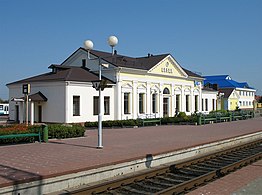
Slutsk train station

Slutsk bus depot in the 1920s

Slutsk Homeland Museum
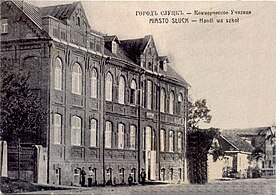
Commercial college
Painting of the Slutsk Defence Action

Calvinist Church and high school
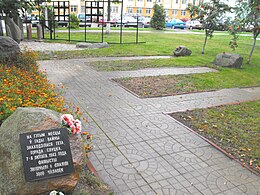
Site of the Slutstk Ghetto (today a playground and park)
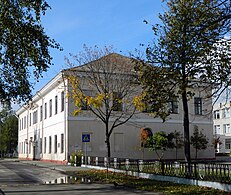
Slutsk high school
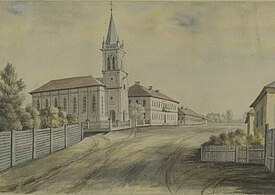
The high school, "The oldest school in Slutsk"

Native Belarusian man

Slutsk family

Studying Talmud in Slutsk
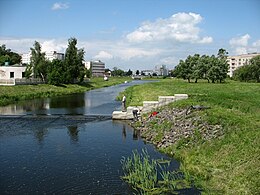
The Slutsk River
External links[]
| Wikimedia Commons has media related to Sluck. |
- Slutsk
- Towns in Belarus
- Populated places in Minsk Region
- Slutsk District
- Slutsky Uyezd
- Dregovichs
- Nowogródek Voivodeship (1507–1795)














